Deutsche Jägerschaft Luxury Hunting Knife by C. Eickhorn
CATEGORY: Version
SKU: 75.GOR.04.02.02.002.000
Estimated market value:

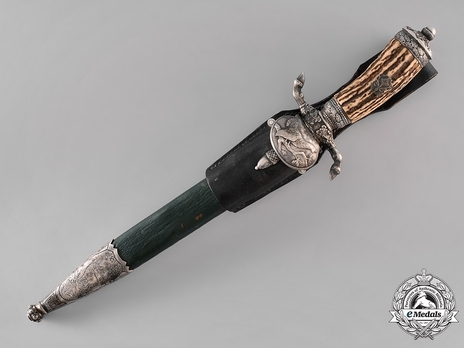
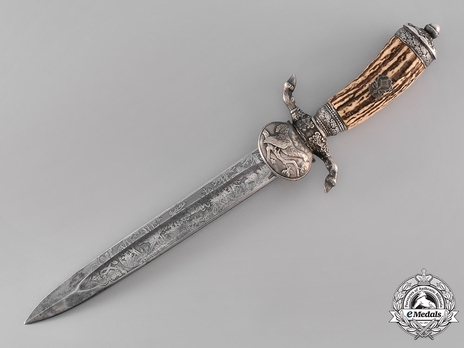
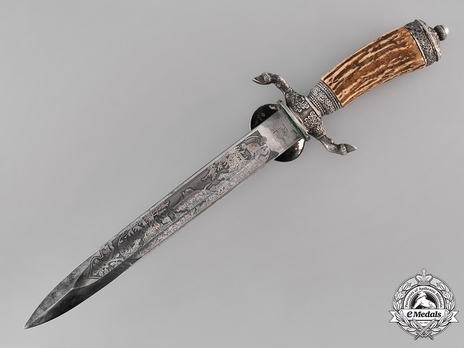
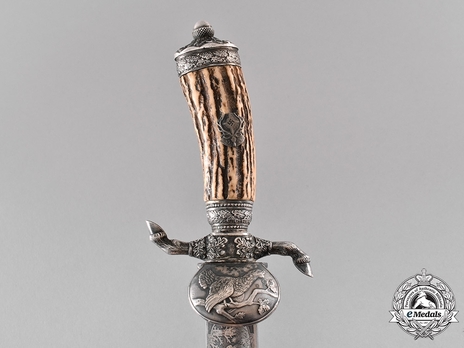
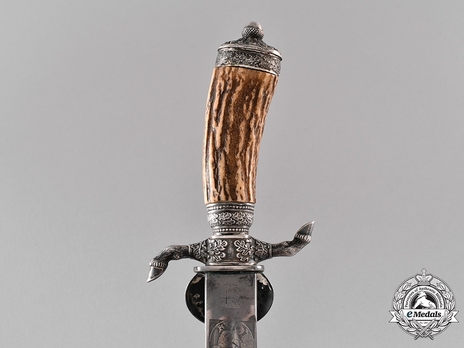
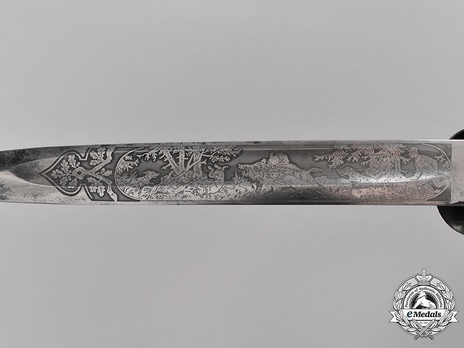
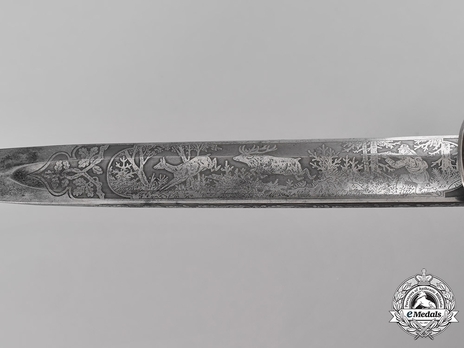
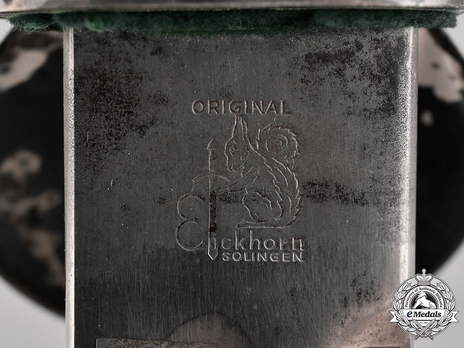
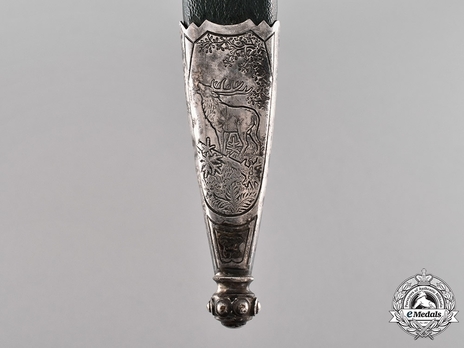
Estimated market value:
Measuring 424 mm with the scabbard on, and featuring a 257 mm nickel-plated steel blade, with factory unsharpened edged, but with a slightly dinged tip. The blade features exceptionally detailed etching on both sides, consisting of a different hunting theme on each side, as well as on the top edge of the dagger. It is maker marked “Eickhorn, Solingen” on the reverse ricasso, and retains its original cross-graining on non-etched surfaces, with a glossy finish on etched surfaces, with only light to moderate scratches to the blade common to extraction and return to the scabbard. The crossguard is constructed of ornately detailed silver nickel, with in the shape of a downward and upward facing hoof, with oak leaf designs on the center of the crossguard, and the washer between the crossguard and the grip. It also features a large quirrel-like structure featuring a large pheasant.The grip itself is constructed of authentic stag that is large in diameter, with beautiful raised gaining and a multitude of natural colours, with a National Hunting Association insignia is correctly pinned, measuring 15.41 mm (w) x 19.02 mm (h). The pommel is equally constructed of nickel silver and features an oak leaf design with an acorn final. Accompanied by its original scabbard and frog. The scabbard is constructed metal (magnetic), with a thick green leather wrapper, with ornately detailed nickel fittings, including a nickel fitting around the throat of the scabbard. The frog is constructed black leather, and is maker marked “Stecher, Freiberg” and is dated “1938”; in overall near mint condition.
Like every organisation during the Third Reich, forestry was placed under the control of the NSDAP. The Reichsforstamt (National Forestry Office) was created in 1934 to replace the regional forestry departments that had existed prior to this date. The goals of the Reichsforstamt were to extract economic value in the form of timber from the forests for the German industry, as well as preserve nature and natural monuments for the people as a part of German culture.
A sub-department for professional hunters employed by the government was created. Hunting matters had formerly been a part of the Ministry for Food and Agriculture, but were now placed under the influence of the Reichsforstamt.
Private forestry matters were placed under the care of the Reichsnährstand (National Nutritional Estate) in 1941.
The Reichsforstamt was headed by Luftwaffe leader Hermann Göring as Reichsforstmeister (minister of forestry).
The Reichsbund Deutsche Jägerschaft (National Society of German Hunters) was founded in 1934 as a statutory corporation for non-professional hunters. All existing hunting societies were disbanded and memberships transferred to the Deutsche Jägerschaft. Membership was mandatory for everyone with a hunting license.
Hermann Göring led the organisation as Reichsjägermeister (minister of hunting).
The Reichsforstschutz or Forstschutzkommando (Forestry Protection Service), in 1943 renamed to Forstschutzkorps (Forestry Protection Corps), was a paramilitary force instituted in February of 1940 in the General Government (occupied Poland). Made up of German forestry officials and ethnic Germans from Poland, the Forstschutz was tasked with regular forestry duties, as well as patrolling and protecting woodlands to keep them from being used by the Polish resistance. In 1942, Forstschutz personnel was also stationed in the Eastern European occupied territories where their work was heavily focused on anti-partisan operations.
Very little is known about the Forstschutz organisation today, and all items related to it are exceedingly rare.
There are two versions of the Deutsche Jägerschaft hunting knife, the regulation version with a length of 490mm or the luxury version measuring 340mm. Both were introduced in 1936. However, the same basic design had already been used for hunting knives during German Imperial and Weimar Republic times.
The fittings on both hilt and scabbard are nickel-silver or nickel-plated. The grip was made of staghorn and features a silver-plated Deutsche Jägerschaft emblem on the obverse. The pommel cap features an acorn. The curved crossguard is in the shape of deer hooves. The hilt features a fluted clamshell. The blade is either plain or etched with hunting scenes and motifs. The scabbard features pebbled green leather. The upper fitting on the scabbard features an acorn that serves to attach the green leather frog.
The luxury version could be purchased by any hunter who chose to pay the higher price it was sold at. In general, this version is shorter and more ornate. The hilt fittings feature an oak leaf design. The clamshell features a picture of a capercaillie. The blade features a deep fuller. The lower scabbard fitting depicts a hunting motif.
Professional hunters were allowed to wear a gold and silver portepee.
The hunting knife is rare.

Comments
Sign in to comment and reply.


Scroll Top